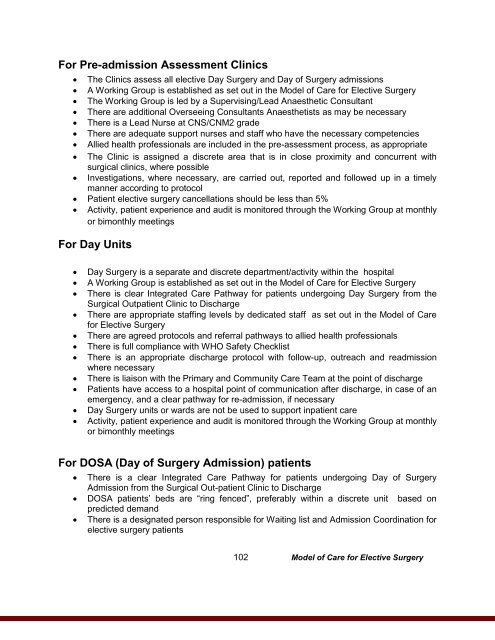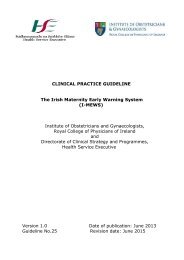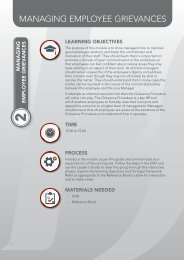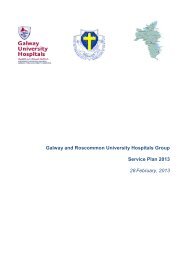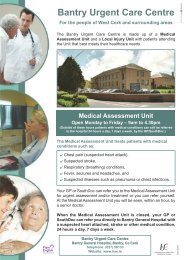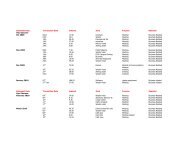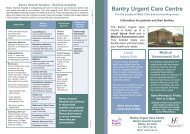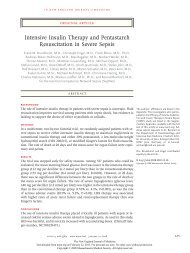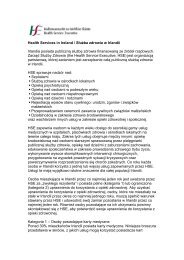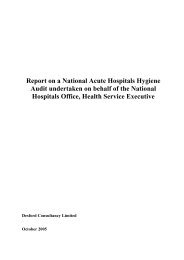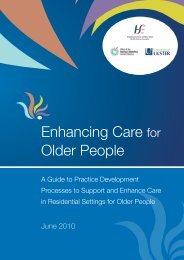Elective Surgery Programme Implementation Support Guide
Elective Surgery Programme Implementation Support Guide
Elective Surgery Programme Implementation Support Guide
Create successful ePaper yourself
Turn your PDF publications into a flip-book with our unique Google optimized e-Paper software.
For Pre-admission Assessment Clinics<br />
The Clinics assess all elective Day <strong>Surgery</strong> and Day of <strong>Surgery</strong> admissions<br />
A Working Group is established as set out in the Model of Care for <strong>Elective</strong> <strong>Surgery</strong><br />
The Working Group is led by a Supervising/Lead Anaesthetic Consultant<br />
There are additional Overseeing Consultants Anaesthetists as may be necessary<br />
There is a Lead Nurse at CNS/CNM2 grade<br />
There are adequate support nurses and staff who have the necessary competencies<br />
Allied health professionals are included in the pre-assessment process, as appropriate<br />
The Clinic is assigned a discrete area that is in close proximity and concurrent with<br />
surgical clinics, where possible<br />
Investigations, where necessary, are carried out, reported and followed up in a timely<br />
manner according to protocol<br />
Patient elective surgery cancellations should be less than 5%<br />
Activity, patient experience and audit is monitored through the Working Group at monthly<br />
or bimonthly meetings<br />
For Day Units<br />
Day <strong>Surgery</strong> is a separate and discrete department/activity within the hospital<br />
A Working Group is established as set out in the Model of Care for <strong>Elective</strong> <strong>Surgery</strong><br />
There is clear Integrated Care Pathway for patients undergoing Day <strong>Surgery</strong> from the<br />
Surgical Outpatient Clinic to Discharge<br />
There are appropriate staffing levels by dedicated staff as set out in the Model of Care<br />
for <strong>Elective</strong> <strong>Surgery</strong><br />
There are agreed protocols and referral pathways to allied health professionals<br />
There is full compliance with WHO Safety Checklist<br />
There is an appropriate discharge protocol with follow-up, outreach and readmission<br />
where necessary<br />
There is liaison with the Primary and Community Care Team at the point of discharge<br />
Patients have access to a hospital point of communication after discharge, in case of an<br />
emergency, and a clear pathway for re-admission, if necessary<br />
Day <strong>Surgery</strong> units or wards are not be used to support inpatient care<br />
Activity, patient experience and audit is monitored through the Working Group at monthly<br />
or bimonthly meetings<br />
For DOSA (Day of <strong>Surgery</strong> Admission) patients<br />
There is a clear Integrated Care Pathway for patients undergoing Day of <strong>Surgery</strong><br />
Admission from the Surgical Out-patient Clinic to Discharge<br />
DOSA patients‟ beds are “ring fenced”, preferably within a discrete unit based on<br />
predicted demand<br />
There is a designated person responsible for Waiting list and Admission Coordination for<br />
elective surgery patients<br />
102 Model of Care for <strong>Elective</strong> <strong>Surgery</strong>


